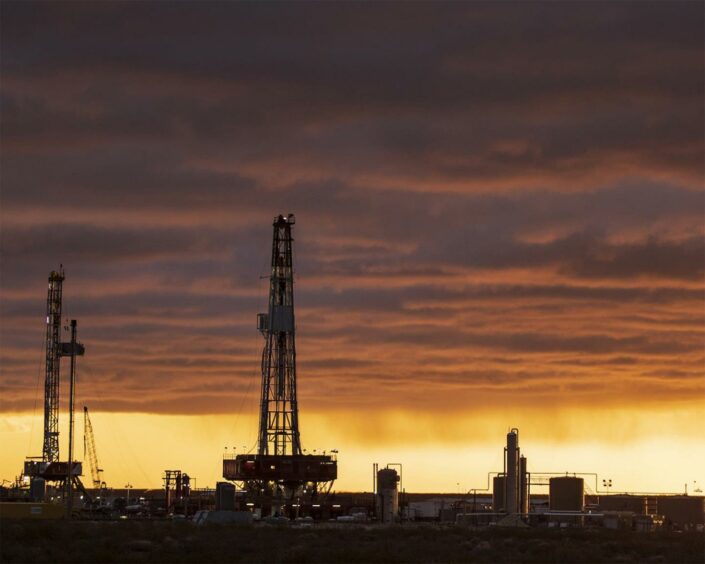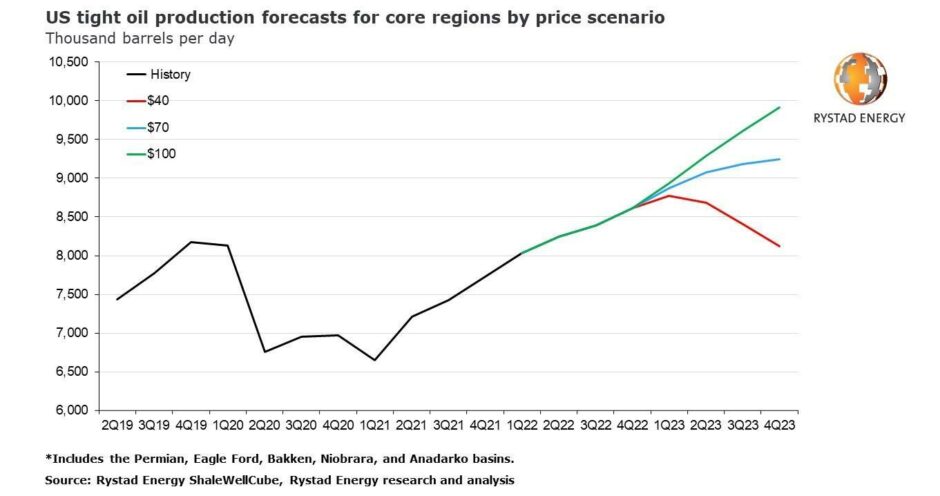
Analysis by Rystad Energy suggests a prolonging of current prices could unlock up to 2.2 million barrels per day (bpd) of US tight oil by next year.
The Oslo-headquartered research group said the market may see a “supercycle” – a sustained period of growth, with oil prices remaining around or above $100 per barrel – as demand continues to grow while supplies remain constrained.
Tight oil output in the core producing regions of the US – the Permian, Eagle Ford, Niobrara, Bakken and Anadarko – in the fourth quarter of 2021 was around 7.7 million bpd, continuing an upward trend but short of the pre-pandemic levels.
It expects production in these regions to surpass the 2019 high of 8.1 million bpd by the second quarter of this year and expand even further if a supercycle were to emerge.
If oil prices reach and remain around $100 per barrel, total production from these core regions would hit 9.9 million bpd by the fourth quarter of 2023 – 2.2 million bpd more than the same quarter in 2021.
High oil prices are encouraging production increases as supply from sources outside the US remains tight. Meanwhile, global Covid-19 concerns are receding as countries remove or relax travel and social restrictions, causing a surge in demand for oil that the current supply would struggle to meet.
At the same time, tensions between Russia and Ukraine have led to growing uncertainty around disruption to trade flows.
Total unconventional output – including oil, gas and natural gas liquids (NGLs) – from the four core US oil regions has already returned to pre-Covid-19 levels, totaling around 15.6 million boepd in the fourth quarter of 2021.
Total output is forecast to reach an all-time high of more than 16 million boepd by April.
“Although high prices would, in theory, trigger a burst in tight oil production, acute supply chain bottlenecks, a lag between price signals and its impact on production, and winter weather-related disruptions will slow growth,” commented Rystad Energy’s head of shale research Artem Abramov.
“Added to this are expectations that spot sand prices will rise to a $50-$70 per ton range – a level unheard of in the industry’s modern history – which will hit operators’ wallets.”
Rystad says a price range of $70-100 per barrel would lead to “a significant upsurge in output” in the fourth quarter of 2022, while a prolonged run of $90-100 per barrel would further fuel recovering rig activity from the second quarter of this year.
In a $40 scenario, production would return to 2021 levels by 2024.
Looking beyond 2023, $100 WTI would allow the industry to average annual growth of about 960,000 bpd from the fourth quarter of 2021 through to the fourth quarter of 2025, analysts said. At $70, the average pace would be limited to about 560,000 bpd per year.
Additional rigs would also be mobilised from the second quarter of this year if $100 was sustained, with both private operators and public independent producers adding capacity.
Rystad notes that “a fundamental shift in the operational philosophy of public E&Ps is emerging,” as the market responds to global call for more tight oil production – as evidenced by ambitious Permian growth plans set out by the likes of ExxonMobil and Chevron.
It adds that there is an upswing in industry sentiment in the Permian and some other basins, and while supply chain bottlenecks may persist, they will not halt growth, given the previous resilience shown by industry to dismantling bottlenecks in the past.
Looking to the rest of the lower 48 conventional production and condensate in shale gas regions – excluding the Gulf of Mexico – Rystad analysts said oil output had stabilised in the 1.7-1.8 million-bpd range, and may reach towards 1.9 million bpd over the next four years in a favourable price environment.
It notes an increase in infill drilling in mature fields and a “robust” condensate production outlook in wet and liquids-rich parts of some gas basins.
Against this backdrop, it said a pre-Covid-19 lower 48 production peak of 10.4 million bpd would be within reach by late 2022 or early 2023.
In a $70 scenario, supply from the lower 48 states is expected to trend towards 12 million bpd by late 2025, while a sustained $100 environment would allow US onshore oil volumes to grow to 13.5 million bpd over the next four years.
Recommended for you

 © Supplied by Rystad Energy
© Supplied by Rystad Energy